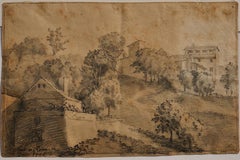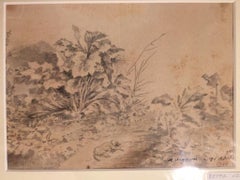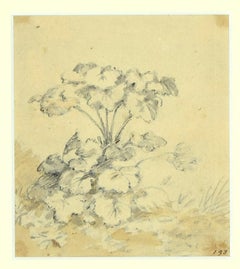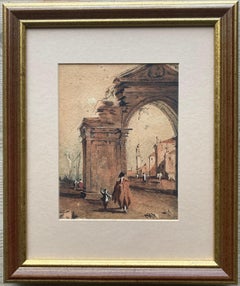Jan Pieter Verdussen Drawings and Watercolor Paintings
to
1
10
6
4
10
Overall Height
to
Overall Width
to
10
2
2
2
1
1
1
1
1
1
1
10
6
10
708
412
288
228
10
8
3
3
Artist: Jan Pieter Verdussen
Landscape - Pencil and Watercolor by Jan Pieter Verdussen - 1750
By Jan Pieter Verdussen
Located in Roma, IT
Landscape is a beautiful drawing in watercolor and pencil on ivory-colored paper realized by Jan Peter Verdussen.
In good condition; only a smallspots at the edges of the drawing an...
Category
1750s Old Masters Jan Pieter Verdussen Drawings and Watercolor Paintings
Materials
Paper, Ink, Watercolor
Rome, The Countryside - China Ink Drawing by Jan Pieter Verdussen - 1742
By Jan Pieter Verdussen
Located in Roma, IT
Rome is a beautiful artwork realized by Jan Peter Verdussen in 1742.
In good condition except for some pencil marks and traces of sealing wax on the back and diffused foxings.
Hand...
Category
Mid-17th Century Old Masters Jan Pieter Verdussen Drawings and Watercolor Paintings
Materials
Paper, Ink
Rome, The Countryside- China Ink Drawing by Jan Pieter Verdussen - 1742
By Jan Pieter Verdussen
Located in Roma, IT
Rome is a beautiful artwork realized by Jan Peter Verdussen in 1742.
In good condition except for some pencil marks and traces of sealing wax on the back and some diffused foxings.
...
Category
Mid-17th Century Old Masters Jan Pieter Verdussen Drawings and Watercolor Paintings
Materials
Paper, Ink
Dog with Plants - Original China Ink Drawing by Jan Pieter Verdussen - 1751
By Jan Pieter Verdussen
Located in Roma, IT
Dog with plants in the garden is a beautiful artwork realized by Jan Peter Verdussen in 1751.
pen and watercolour on brown paper. In good codition except for some pencil marks and t...
Category
Mid-17th Century Old Masters Jan Pieter Verdussen Drawings and Watercolor Paintings
Materials
Paper, Ink
Plants - Original China Ink Drawing by Jan Pieter Verdussen - 1740
By Jan Pieter Verdussen
Located in Roma, IT
Plants is a beautiful artwork realized by Jan Peter Verdussen in 1740.
pen and watercolour on brown paper. In good codition except for some pencil marks and traces of sealing wax on...
Category
Mid-17th Century Old Masters Jan Pieter Verdussen Drawings and Watercolor Paintings
Materials
Ink, Paper
Garden's Flowers - Ink and Watercolor Drawing by Jan Pieter Verdussen - 1750s
By Jan Pieter Verdussen
Located in Roma, IT
Garden's Flowers is a beautiful artwork realized by Jan Peter Verdussen.
In good condition.
Not signed.
Passepartout included ( 48.8 x 33.8 cm).
The artwork represents a Garden's...
Category
Mid-18th Century Old Masters Jan Pieter Verdussen Drawings and Watercolor Paintings
Materials
Paper, Ink, Watercolor
Speech - Original China Ink Drawing by Jan Pieter Verdussen - Mid 1747
By Jan Pieter Verdussen
Located in Roma, IT
Speech is an original and unique drawing in ink on paper realized by Jan Peter Verdussen, with sketches on the rear.
The State of preservation is very good with the traces of time.
...
Category
1740s Old Masters Jan Pieter Verdussen Drawings and Watercolor Paintings
Materials
Paper, Ink
Turin Countryside - Original Ink and Watercolor by Jan Pieter Verdussen - 1744
By Jan Pieter Verdussen
Located in Roma, IT
China ink and Watercolour. With handwritten notes, indicating the place and date of the artwork in lower margin: "Fait proche de Turin, ce 13 Juin 1744". Numbered on the lower right ...
Category
1740s Old Masters Jan Pieter Verdussen Drawings and Watercolor Paintings
Materials
Paper, Ink, Watercolor
Figure of Breton Woman - Drawing by J. P. Verdussen - End of 18th Century
By Jan Pieter Verdussen
Located in Roma, IT
Figure of Breton Woman is a beautiful ink and watercolor original drawing on wire rod and watermarked paper realized at the middle of XVIII century by Jan Peter Verdussen.
This ori...
Category
Early 18th Century Old Masters Jan Pieter Verdussen Drawings and Watercolor Paintings
Materials
Paper
Flora Study - Drawing by J. P. Verdussen - End of 18th Century
By Jan Pieter Verdussen
Located in Roma, IT
Watercolour. Hand-Numbered "312" lower-right on margin. In very good condition except a little stain on the high left corner. Wonderful Watercolour drawing by Jan Peeter Verdussen, s...
Category
Early 18th Century Old Masters Jan Pieter Verdussen Drawings and Watercolor Paintings
Materials
Paper
Related Items
Fine 1700's Italian Old Master Ink & Wash Drawing Roman Allegorical Insubria
Located in Cirencester, Gloucestershire
'Insubria'
Italian School, 18th century
ink and wash drawing on paper, framed within a light oak wood frame (behind glass)
image size: 10.5 x 7 inches
overall framed: 17 x 13 inches
...
Category
18th Century Old Masters Jan Pieter Verdussen Drawings and Watercolor Paintings
Materials
Watercolor, Ink, Archival Paper
Follower of Francesco Guardi, Figures in a Mediterranean port by a Roman Arch
By Francesco Guardi
Located in Harkstead, GB
A lively, well executed sketch painted by a 19th century follower of Francesco Guardi
Follower of Francesco Guardi, 19th Century
Figures by a Roman Arch
Watercolour with ink and sc...
Category
19th Century Old Masters Jan Pieter Verdussen Drawings and Watercolor Paintings
Materials
Paper, Ink, Watercolor
Free Shipping
H 6.5 in W 5 in D 1 in
The Abduction of the Sabine Women , a Renaissance drawing by Biagio Pupini
Located in PARIS, FR
This vigorous drawing has long been attributed to Polidoro da Caravaggio: The Abduction of the Sabine Women is one of the scenes that Polidoro depicted between 1525 and 1527 on the façade of the Milesi Palazzo in Rome. However, the proximity to another drawing inspired by this same façade, kept at the Ecole des Beaux-Arts, and to other drawings inspired by Polidoro kept at the Musée du Louvre, leads us to propose an attribution to Biagio Pupini, a Bolognese artist whose life remains barely known, despite the abundant number of drawings attributed to him.
1. Biagio Pupini, a Bolognese artist in the light of the Roman Renaissance
The early life of Biagio Pupini, an important figure of the first half of the Cinquecento in Bologna - Vasari mentions him several times - is still poorly known. Neither his date of birth (probably around 1490-1495) nor his training are known. He is said to have been a pupil of Francesco Francia (1450 - 1517) and his name appears for the first time in 1511 in a contract with the painter Bagnacavallo (c. 1484 - 1542) for the frescoes of a church in Faenza. He then collaborated with Girolamo da Carpi, at San Michele in Bosco and at the villa of Belriguardo.
He must have gone to Rome for the first time with Bagnacavallo between 1511 and 1519. There he discovered the art of Raphael, with whom he might have worked, and that of Polidoro da Caravaggio. This first visit, and those that followed, were the occasion for an intense study of ancient and modern art, as illustrated by his abundant graphic production.
Polidoro da Caravaggio had a particular influence on the technique adopted by Pupini. Executed on coloured paper, his drawings generally combine pen, brown ink and wash with abundant highlights of white gouache, as in the drawing presented here.
2. The Abduction of the Sabine Women
Our drawing is an adaptation of a fresco painted between 1525 and 1527 by Polidoro da Caravaggio on the façade of the Milesi Palace in Rome. These painted façades were very famous from the moment they were painted and inspired many artists during their stay in Rome. These frescoes are now very deteriorated and difficult to see, as the palace is in a rather narrow street.
The episode of the abduction of the Sabine women (which appears in the centre of the photo above) is a historical theme that goes back to the origins of Rome and is recounted both by Titus Livius (Ab Urbe condita I,13), by Ovid (Fasti III, 199-228) and by Plutarch (II, Romulus 14-19). After killing his twin brother Romus, Romulus populates the city of Rome by opening it up to refugees and brigands and finds himself with an excess of men. Because of their reputation, none of the inhabitants of the neighbouring cities want to give them their daughters in marriage. The Romans then decide to invite their Sabine neighbours to a great feast during which they slaughter the Sabines and kidnap their daughters.
The engraving made by Giovanni Battista Gallestruzzi (1618 - 1677) around 1656-1658 gives us a good understanding of the Polidoro fresco, allowing us to see how Biagio Pupini reworked the scene to extract this dynamic group.
With a remarkable economy of means, Biagio Pupini takes over the left-hand side of the fresco and depicts in a very dense space two main groups, each consisting of a Roman and a Sabine, completed by a group of three soldiers in the background (which seems to differ quite significantly from Polidoro's composition).
The balance of the drawing is based on a very strongly structured composition. The drawing is organised around a median vertical axis, which runs along both the elbow of the kidnapped Sabine on the left and the foot of her captor, and the two main diagonals, reinforced by four secondary diagonals. This diamond-shaped structure creates an extremely dynamic space, in which centripetal movements (the legs of the Sabine on the right, the arm of the soldier on the back at the top right) and centrifugal movements (the arm of the kidnapper on the left and the legs of the Sabine he is carrying away, the arm of the Sabine on the right) oppose each other, giving the drawing the appearance of a whirlpool around a central point of support situated slightly to the left of the navel of the kidnapper on the right.
3. Polidoro da Caravaggio, and the decorations of Roman palaces
Polidoro da Caravaggio was a paradoxical artist who entered Raphael's (1483 - 1520) workshop at a very young age, when he oversaw the Lodges in the Vatican. Most of his Roman work, which was the peak of his career, has disappeared, as he specialised in facade painting, and yet these paintings, which are eminently visible in urban spaces, have influenced generations of artists who copied them abundantly during their visits to Rome.
Polidoro Caldara was born in Caravaggio around 1495-1500 (the birthplace of Michelangelo Merisi, known as Caravaggio, who was born there in 1571), some forty kilometres east of Milan. According to Vasari, he arrived as a mason on the Vatican's construction site and joined Raphael's workshop around 1517 (at the age of eighteen according to Vasari). This integration would have allowed Polidoro to work not only on the frescoes of the Lodges, but also on some of the frescoes of the Chambers, as well as on the flat of Cardinal Bibiena in the Vatican.
After Raphael's death in 1520, Polidoro worked first with Perin del Vaga before joining forces with Maturino of Florence (1490 - 1528), whom he had also known in Raphael's workshop. Together they specialised in the painting of palace façades. They were to produce some forty façades decorated with grisaille paintings imitating antique bas-reliefs.
The Sack of Rome in 1527, during which his friend Maturino was killed, led Polidoro to flee first to Naples (where he had already stayed in 1523), then to Messina. It was while he was preparing his return to the peninsula that he was murdered by one of his assistants, Tonno Calabrese, in 1543.
In his Vite, Vasari celebrated Polidoro as the greatest façade decorator of his time, noting that "there is no flat, palace, garden or villa in Rome that does not contain a work by Polidoro". Polidoro's facade decorations, most of which have disappeared as they were displayed in the open air, constitute the most important lost chapter of Roman art of the Cinquecento. The few surviving drawings of the painter can, however, give an idea of the original appearance of his murals and show that he was an artist of remarkable and highly original genius.
4. The façade of the Milesi Palace
Giovanni Antonio Milesi, who commissioned this palace, located not far from the Tiber, north of Piazza Navona, was a native of the Bergamo area, like Polidoro, with whom he maintained close friendly ties. Executed in the last years before the Sack of Rome, around 1526-1527, the decoration of Palazzo Milesi is considered Polidoro's greatest decorative success.
An engraving by Ernesto Maccari made at the end of the nineteenth century allows us to understand the general balance of this façade, which was still well preserved at the time. The frescoes were not entirely monochrome, but alternated elements in chiaroscuro simulating marble bas-reliefs and those in ochre simulating bronze and gold vases...
Category
16th Century Old Masters Jan Pieter Verdussen Drawings and Watercolor Paintings
Materials
Ink, Gouache, Pen
Original Set-Breakfast with Cat Series-British Award Artist-Gold, ink on papers
Located in London, GB
These two drawings as a set, encapsulate the enchanting moments experienced during a series of breakfasts at Shizico Yi's Scotland home. Created plein air and in situ, these scenes u...
Category
2010s Contemporary Jan Pieter Verdussen Drawings and Watercolor Paintings
Materials
Gold
H 16.54 in W 23.63 in D 0.04 in
Josephus Augustus Knip (1777-1847), Picturesque Landscape Of The Alps
Located in PARIS, FR
Josephus Augustus KNIP
Tilbourg 1777 - Berlicum 1847
Picturesque landscape of the Alps with anthropomorphic rock
Circa 1800
Watercolor, gouache and brown ink
Signed lower left
47 x ...
Category
Early 19th Century Old Masters Jan Pieter Verdussen Drawings and Watercolor Paintings
Materials
Watercolor, Laid Paper
1600’s Flemish Old Master Ink Wash Drawing Biblical Figures Group on paper
Located in Cirencester, Gloucestershire
Figure Studies
Attriubted to Cornelis Schut
(1597 - 1655) Flemish
ink drawing on paper, inscribed on mount
size: 4.75 x 7 inches
private collection, France
The painting is in overa...
Category
Early 17th Century Old Masters Jan Pieter Verdussen Drawings and Watercolor Paintings
Materials
Watercolor, Ink
Fine 1700's Italian Old Master Ink & Wash Drawing Roman Allegorical Figure Fame
Located in Cirencester, Gloucestershire
'Fame'
Italian School, 18th century
ink and wash drawing on paper, framed within a light oak wood frame (behind glass)
image size: 10.5 x 7 inches
overall framed: 17 x 13 inches
cond...
Category
18th Century Old Masters Jan Pieter Verdussen Drawings and Watercolor Paintings
Materials
Watercolor, Ink, Archival Paper
Baldassarre Franceschini, Sleeping Cupid, Valentine's Day Gift
Located in Harkstead, GB
A beautiful 19th century copy by Giuseppe Rocchi of Baldassarre Franceschini's Sleeping Cupid, presented in a very attractive gilt frame with hand carved mouldings. A very peaceful i...
Category
Mid-19th Century Old Masters Jan Pieter Verdussen Drawings and Watercolor Paintings
Materials
Paper, Watercolor
Fine 1700's Italian Old Master Ink & Wash Drawing Roman Allegorical Providenza
Located in Cirencester, Gloucestershire
'Providenza'
Italian School, 18th century
ink and wash drawing on paper, framed within a light oak wood frame (behind glass)
image size: 10.5 x 7 inches
overall framed: 17 x 13 inche...
Category
18th Century Old Masters Jan Pieter Verdussen Drawings and Watercolor Paintings
Materials
Watercolor, Ink, Archival Paper
Fine 1700's Italian Old Master Ink & Wash Drawing Roman Female Statue of Beauty
Located in Cirencester, Gloucestershire
Belleza (The Art of Beauty)
Italian School, 18th century
ink and wash drawing on paper, framed within a light oak wood frame (behind glass)
image size: 10.5 x 7 inches
overall framed...
Category
18th Century Old Masters Jan Pieter Verdussen Drawings and Watercolor Paintings
Materials
Ink, Archival Paper, Watercolor
Gustav Melcher ( German, 1898 -?) Boats off Venice Italy Ink Water Color c. 1918
By Gustav Melcher
Located in Meinisberg, CH
Gustav Melcher
(German, 1898-?)
Segelschiffe vor Venedig - Sailing ships off Venice
• India ink, water colour wash
• Visible image ca. 11.5 x 18 cm
• Glased Frame ca. 20 x 25 cm
• Verso various inscriptions
• Signed lower right
Gustav Melcher was a German painter and a pioneer in film, film criticism and film theory and created this clever little picture of the skyline of Venice with various vessels.
Going by the various inscriptions an the backing paper, this drawing was made in 1918 when Gustav was twenty years old and passed on three years later to Gertrud Melcher on the 1. 2. 1921. I have no reasons to doubt this information. The small drawing is still in its unopened frame, so maybe there is more information to be discovered , however this will be the privilege of the next owner.
The picture also has retained its original antique frame – note that it has lost over the years various sections of the gesso decoration.
The very precisely executed drawing is most enjoyable to look at and doing so, remember you are looking through the eyes of a young man, who saw this foreign sea cape over a century ago.
Thank you for your interest and please note, that I offer free worldwide shipping on all my items.
Gustav Melcher began his studies at the Düsseldorfer Kunstakademie under Peter Janssen and Eduard von Gebhardt. Originaly he was interested in figurative and portrait painting, but after time he decided to pursue the depiction of land- and marinescapes. Durin his studies the young artist undertook trips to visit England, Scotland, Belgium and France and he joined the artist society Malkasten. It was in those days he would hold speeches to his colleges about this new invention called ‘Kintopp’ – Melcher was a great advocate of the moving pictures...
Category
1910s Naturalistic Jan Pieter Verdussen Drawings and Watercolor Paintings
Materials
India Ink, Paper, Watercolor
Gustav MelcherGustav Melcher ( German, 1898 -?) Boats off Venice Italy Ink Water Color c. 1918, 1918
Free Shipping
H 7.88 in W 9.85 in D 0.79 in
Fine 1700's Italian Old Master Ink & Wash Drawing Roman Allegorical Africa
Located in Cirencester, Gloucestershire
'Africa'
Italian School, 18th century
ink and wash drawing on paper, framed within a light oak wood frame (behind glass)
image size: 10.5 x 7 inches
overall framed: 17 x 13 inches
co...
Category
18th Century Old Masters Jan Pieter Verdussen Drawings and Watercolor Paintings
Materials
Watercolor, Ink, Archival Paper
Jan Pieter Verdussen drawings and watercolor paintings for sale on 1stDibs.
Find a wide variety of authentic Jan Pieter Verdussen drawings and watercolor paintings available for sale on 1stDibs. You can also browse by medium to find art by Jan Pieter Verdussen in paper, ink, paint and more. Much of the original work by this artist or collective was created during the 18th century and earlier and is mostly associated with the Old Masters style. Not every interior allows for large Jan Pieter Verdussen drawings and watercolor paintings, so small editions measuring 5 inches across are available. Customers who are interested in this artist might also find the work of Émile Jean-Horace Vernet , and Michela De Vito. Jan Pieter Verdussen drawings and watercolor paintings prices can differ depending upon medium, time period and other attributes. On 1stDibs, the price for these items starts at $357 and tops out at $1,615, while the average work can sell for $798.






